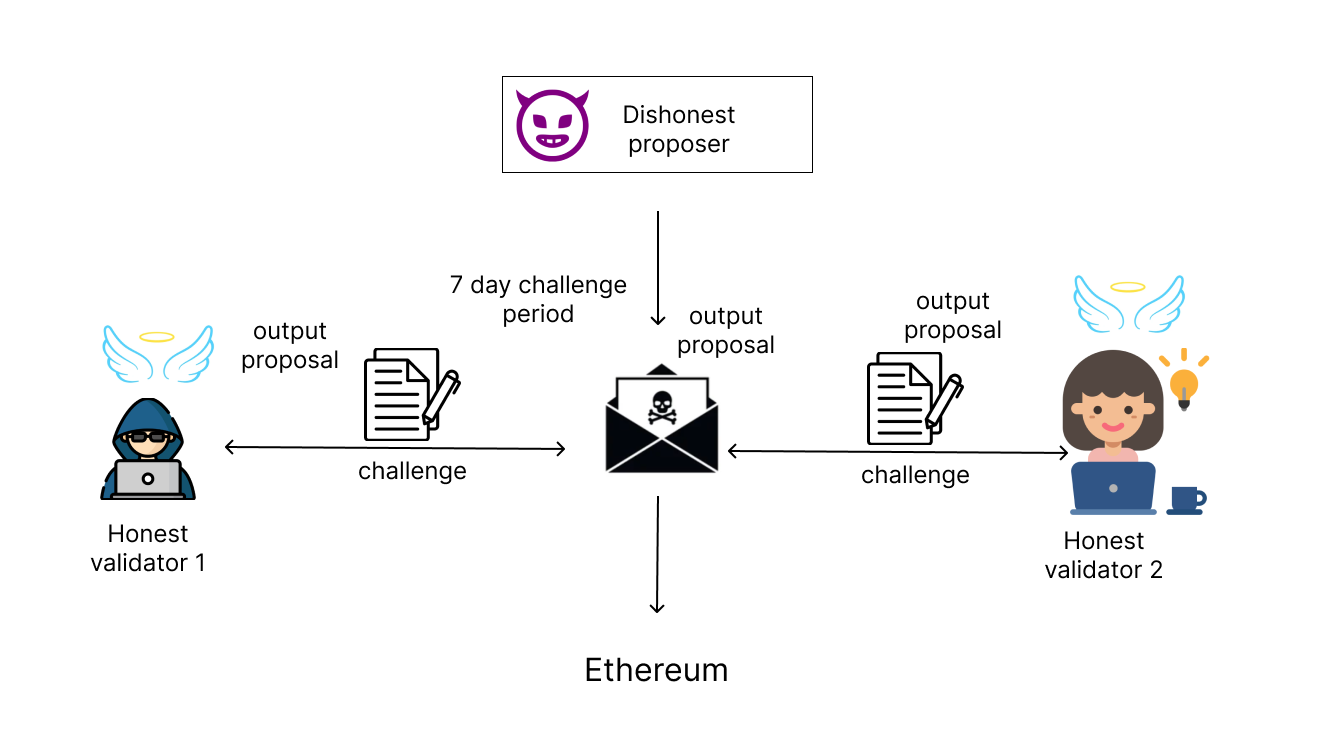- allowing anyone to make proposals about the state of the L2
- allowing anyone to challenge proposals made by other users
- allowing users to send messages from L2 to L1 without the need for a trusted third party
- allowing users to trigger withdrawals from L2 to L1 without the need for a trusted third party
- introducing a modular fault proof design that can easily integrate additional proving mechanisms
PROPOSER and CHALLENGER roles can submit and challenge proposals.
Permissionless proposals
“Proposals” or “State Proposals” are claims about the state of an OP Stack chain that are submitted to Ethereum through theDisputeGameFactory contract.
Proposals can be used for many things but are most commonly used by end-users to prove that they created a withdrawal on an OP Stack chain.
With the Fault Proofs upgrade to the OP Stack, proposals become permissionless and can be submitted by anyone.
See the permissionless fault proofs diagram below for more details:

Permissionless challenges
Because anyone can submit a proposal, it’s important that invalid proposals can be challenged. In Optimistic Rollups like OP Stack Chains there is a ~1 week challenge period during which users can challenge a proposal if they believe it to be incorrect. With the Fault Proofs upgrade to the OP Stack, challenges become permissionless and can be submitted by anyone. Any user can run a node for the OP Stack chain in question and use theop-challenger tool to participate in the dispute process.
Modular design and multi-layer security
The OP Stack Fault Proof System is modular in design and lays the groundwork for achieving a “multi-proof” system. This allows the OP Stack to support multiple proof systems alongside the initial Cannon proof system. With multiple proof systems in place, the OP Stack can be more resilient to potential attacks and bugs in any one proof system. Additionally, the following security safeguards have been built around the game, as follows:- An off chain monitoring system has been set up to monitor all proposed roots and ensure they align with the correct state. See
op-dispute-monfor more details. - After a root is finalized through a game, an additional delay called the “airgap window” has been added before withdrawals can occur. During this period, the
GUARDIANrole can reject the root. - A contract called
DelayedWETHhas been set up to hold the bonds and only allow payouts after a delay, so that bonds can be redirected towards the correct recipient in the case that a game resolves incorrectly.
Next steps
- Ready to get started? Review the FP Components to learn how the different components work together to enhance decentralization in the Optimism ecosystem.
- See the Fault Proof Security to understand changes to
OptimismPortalandFaultDisputeGamecontracts. - For more info about how the FP system works under the hood, check out the specs.
FAQs
How many steps/transactions are required to settle a dispute (worst-case scenario)?
The maximum depth of a game is 73, but there can be any number of claims and counter-claims within a dispute game. Due to the permissionless structure where many different actors can participate in the same game, a single claim may be countered by any number of different counter-claims, effectively combining multiple disputes into a single game.Are there any dependencies to consider when proposing a new state root (in the event of sequencer and proposer failure)?
Users can complete the full withdrawal cycle without depending on any privileged action. The Guardian role can override the system by pausing withdrawals, blacklisting games, or reverting to a permissioned system. As a result, the trust assumption is reduced to requiring only that the Guardian role does not act to intervene, inline with the stage 1 requirements.Since the roles of proposer and challenger will be open to everyone, are guides available outlining the best practices for running them?
It’s not expected that normal users runop-proposer to regularly propose output roots.
Users would generally just propose a single output root if they need to withdraw and the chain operator isn’t proposing outputs for them via direct calls to the DisputeGameFactory via Etherscan.
The
create-game subcommand of op-challenger is for testing purposes only and should not be used in production environments. It is not intended as a replacement for proper op-proposer infrastructure.op-challenger, see the OP-Challenger explainer and how to configure challenger for your chain.
How much ETH should a chain operator put aside to operate the Fault Proof System?
The nominal operating cost of running FPs (i.e., assuming no invalid proposals or malicious actors) will depend on the initial bond set for theFaultDisputeGame and the frequency of posting proposals.
Assuming OP Mainnet parameters, where proposals will be posted hourly, that’s 0.08 ETH per hour.
Assuming a 7 day dispute window, you’ll need roughly 14 ETH (including gas costs) to make proposals.
If chains are using the similar FP deploy configs as OP Mainnet, it’s recommended to stick to a 0.08 ETH initial bond.
However, the capital requirements for operating a FP chain in itself are much larger than 14 ETH.
An operator that secures their chain using FPs must be willing to stake a lot of ETH to secure the chain.
One may decide the capital requirements aren’t worth it, and use only a Permissioned FP system.
The capital requirements will be improved in the later stages of Fault Proofs to make it more feasible for smaller chains.
How large are the bonds expected to be needed to sustain and win a dispute?
The bonds are sized based on the anticipated cost to post a counter-claim as well as to deter spamming invalid claims. As an example, on OP Sepolia, the game0xcf8f181497DAD07277781517A76cb131C54A1BEE shows the escalating bond sizes.
The list-claims subcommand of op-challenger can also provide a good view of the claims in the game: